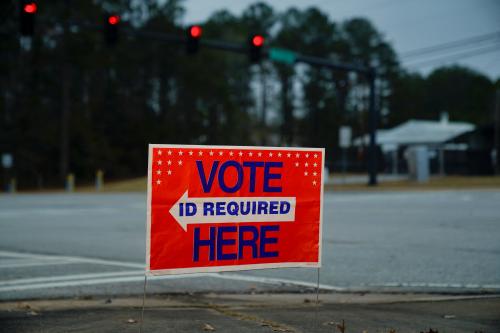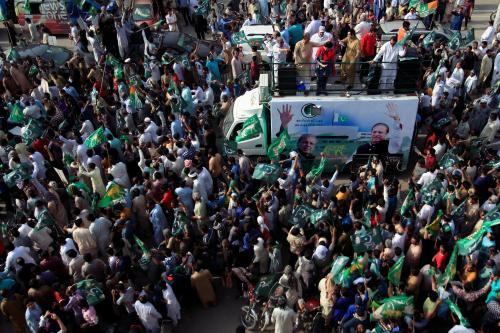The Presidential elections on August 20th is both an opportunity and a challenge for the Taliban and Al-Qaeda. Having staged a spectacular comeback in the last six years they now have the opportunity to demonstrate their power by disrupting the vote and intimidating Afghan voters. But it is also a challenge to show they do have the strength to be a destabilizing factor in the country as a whole, not just the Pashtun south and east, and in the face of the reinforced NATO security forces and the growing Afghan national security forces. In short, the election will be a good test of just how bad the Taliban led insurgency has become.
The U.S. commander in Afghanistan, General Stanley McChrystal, has said the Taliban have the momentum now and are winning the war. That judgment is consistent with the assessments of most experts. It is a remarkable turn of play from where we were in 2001. Then, in only a couple of months, a relatively small number of CIA operatives backed by American airpower and special forces toppled the Taliban’s Islamic Emirate of Afghanistan with few casualties and drove the Taliban leadership and its Al-Qaeda allies into Pakistan. Secretary of Defense Rumsfeld said the Taliban were in the “dust bin of history.”
The Taliban’s leader did not agree. Mullah Muhammad Omar said shortly after the “catastrophe” (his word) that “I am considering two promises. One is the promise of God, the other of Bush. The promise of God is that my land is vast. If you start a journey on God’s path, you can reside anywhere and will be protected. The promise of Bush is that there is no place on earth where you can hide that I cannot find you. We will see which promise is fulfilled.” By hiding in Pakistan and carefully rebuilding their strength in the Pashtun inhabited south and east of Afghanistan, Mullah Omar and his lieutenants slowly at first and then with rising momentum staged their come back.
The numbers show it clearly. In 2004, according to CENTCOM, the Taliban initiated about 50 attacks a week. By 2006 that had doubled to 100 per week. It doubled again in 2007, reached 300 per week in 2008 and toped 400 a week this last May. In 2003 the Taliban were active in only 30 of Afghanistan’s 364 districts, in 2008 they were a player in some 160.
Omar and the Taliban have promised to disrupt voting on the 20th and told Afghans not to come to the polls. They will try to assassinate one or more of the candidates. They have already had an intimidating impact in some areas. In the northern province of Kunduz, where German and Hungarian troops are stationed, the authorities have already decided to keep at least 22 polling stations closed due to poor security out of 216. Kunduz has generally been considered one of the safer provinces in the country.
The Taliban also faces a challenge, however, in staging a national offensive against the political process. For the most part it has not been successful in developing the insurgency in areas where the Pashtun minority (about forty percent of Afghans) does not live. In parts of the country dominated by Tajiks, Uzbeks or Shia the Taliban has been unable to gain much traction or carry out systematic violence. In the capital, Kabul, it has staged several spectacular attacks and occasional rocket shelling but not a sustained presence.
In short, the election is a test both for NATO and the Afghan government in their ability to pull off a credible election day and for the Taliban to upset it. The results are likely to be mixed and thus should be assessed carefully.
In any case, Omar and his shura council have been planning intensively for the days after the election. They will claim any victor is a traitor to Afghanistan for working with NATO and the Crusader foreigners. Omar has had a new code of conduct written for the prosecution of the war, in effect a hand book to be disseminated among the rank and file to guide them in the next stage of the struggle. It is intended to enforce greater discipline and unity in what has been traditionally a complex and largely autonomous movement. A copy has been obtained by Al-Jazeera, the Qatar based news agency, and it shows Omar has personally endorsed the new hand book and its rules of the road. This included guidance on when to use suicide bombers (only against big targets) and on how to deal with captured enemies. The Taliban has separately said that Omar’s shura council will determine the fate of the American soldier they captured this summer.
But a handbook for jihad is neither a political program nor an ideology. The intensely secretive Mullah Omar has never shown much interest in laying out a program for how to govern. He abhors the media and speaks rarely, usually only about his conviction that time and God are on his side and his support for other jihadist causes around the globe. Most Afghans, according to reliable polling, do not want the Taliban back in power. They remember its rule as a medieval hell, with women banned from schools, the country’s national treasures destroyed and the economy virtually moribund. The Taliban’s renaissance has much more to do with America’s mistakes than the attraction of the insurgents.
Which means the conflict is not yet lost. The election may be an important initial milestone in turning around the momentum. If NATO and the Afghan National Army can protect most voters from the Taliban’s intimidation and the Afghans judge the results as credible, it will be a setback to Omar and his backers. If he disrupts the election, the momentum will swing even further in the Taliban’s direction.


Commentary
Op-edThe Taliban and the Afghan Elections
August 12, 2009